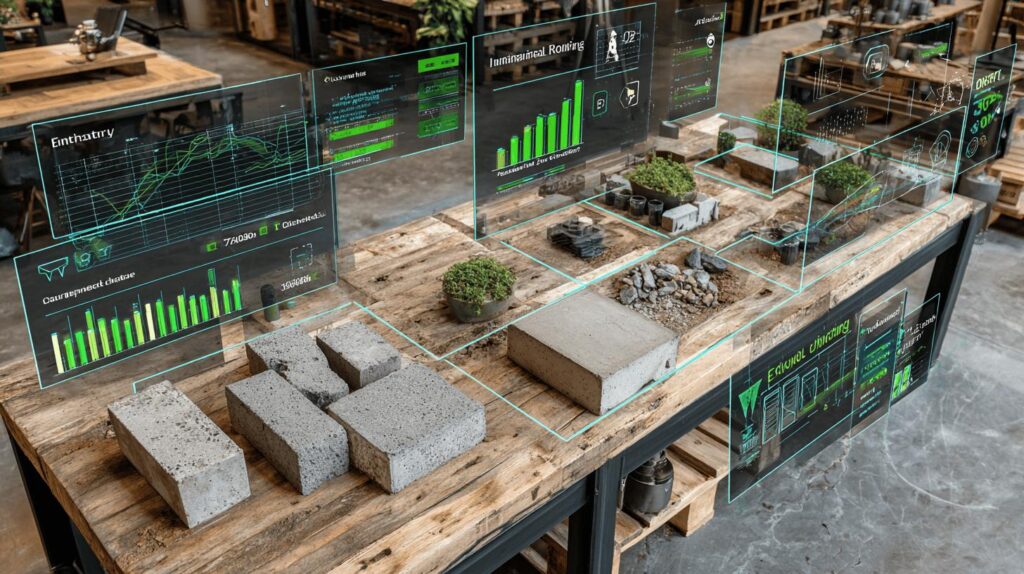
Concrete accounts for approximately 8% of global CO2 emissions – but what if transparent reporting could significantly move the needle on this figure? Environmental Product Declarations (EPDs) for concrete offer construction companies standardized, verified data to clearly quantify and compare environmental impacts across products and suppliers. Instead of manually gathering inconsistent lifecycle data, industry leaders increasingly leverage EPDs to streamline regulatory compliance, meet sustainability mandates, and boost market competitiveness. Here’s how your team can modernize carbon data workflows – and meet rising expectations with confidence.
Understanding EPD Concrete: Definition and Importance
Environmental Product Declarations (EPDs) for concrete are independently verified reports created in accordance with ISO 14025, quantifying precise environmental impacts throughout the product’s full lifecycle – from raw material extraction to manufacturing and disposal. Similar to nutritional labels on food products, EPD concrete reporting provides clear, standardized data that facilitates direct comparisons between products based on sustainability performance.
Concrete production significantly contributes to global emissions, accounting for approximately 8% of global CO₂ output – primarily due to the energy-intensive processes involved in cement manufacturing. Given these substantial impacts, the concrete industry faces mounting pressure from regulators, stakeholders, and consumers to transparently disclose environmental footprints and actively manage sustainability improvements.
EPDs play a central role in sustainable cement assessments, providing verified, objective information on key environmental indicators such as global warming potential (carbon footprint), ozone depletion, resource depletion, and acidification potential. These metrics help manufacturers, architects, and sustainability managers select concrete formulations with lower environmental impacts, driving market-wide improvements in sustainability performance.
Concrete EPDs also support compliance with environmental regulations and standards, such as the European Construction Products Regulation (CPR), Leadership in Energy and Environmental Design (LEED), and green building certifications worldwide. By transparently disclosing environmental impacts, manufacturers can proactively align with regulatory requirements, reduce compliance risks, and demonstrate leadership in sustainability reporting.
The importance of accurate and detailed EPD concrete reporting extends across the construction value chain:
– Manufacturers leverage EPDs to identify carbon hotspots and optimize processes, reducing emissions and costs.
– Architects and designers rely on credible EPD data to specify sustainable cement alternatives and meet project sustainability objectives.
– Supply chain managers utilize EPDs to maintain transparency, manage Scope 3 emissions, and ensure alignment with sustainability directives like the Corporate Sustainability Reporting Directive (CSRD).
Through standardized environmental product declarations for cement, the concrete sector can effectively measure, reduce, and communicate sustainability achievements, positioning itself to meet evolving market expectations and regulatory demands.
How EPD Concrete is Created: Lifecycle Analysis Methodology

Creating Environmental Product Declarations (EPDs) for concrete involves conducting comprehensive Life Cycle Assessments (LCAs). These assessments quantify environmental impacts systematically, following international standards such as EN 15804, ISO 21930, and ISO 14025. LCAs track emissions and resource use across the entire lifecycle of concrete – from raw material extraction through manufacturing, transportation, usage, and ultimately disposal or recycling.
The lifecycle analysis methodology for concrete typically involves these key stages:
1. Material sourcing: This initial stage assesses environmental impacts associated with extracting raw materials, such as limestone, aggregates, and supplementary cementitious materials like fly ash or slag.
2. Manufacturing: Here, LCAs evaluate energy consumption, emissions, and waste generated during cement production, concrete batching, mixing, and curing processes.
3. Transportation: This phase quantifies emissions resulting from transporting materials to production facilities and delivering finished concrete to construction sites.
4. Usage and maintenance: Impacts related to concrete’s service life, including durability, maintenance frequency, and longevity, are assessed at this stage.
5. End-of-life: Finally, LCAs consider impacts from demolition, disposal, recycling, or reuse of concrete materials.
To accurately measure these impacts, LCAs require detailed data collection covering inputs, outputs, and environmental emissions at each lifecycle phase. Precise data on energy consumption, fuel types, resource usage, emissions, waste, and recycling rates are crucial.
Environmental indicators typically reported in concrete LCAs include:
– Global warming potential (measured in CO₂ equivalents)
– Ozone layer depletion potential
– Acidification potential (acid rain formation)
– Eutrophication potential (water nutrient pollution)
– Photochemical ozone creation (smog formation)
– Abiotic depletion potential (resource depletion)
Standardized calculation methodologies and clearly defined guidelines provided by ISO and EN standards ensure consistency, transparency, and credibility in concrete lifecycle analysis. This rigorous approach allows manufacturers and supply chain managers to identify emissions hotspots, benchmark environmental performance, and implement targeted sustainability improvements.
Regulatory Alignment and Standards for EPD Concrete
Environmental Product Declarations (EPDs) for concrete must strictly align with recognized international standards, primarily ISO 14025 and EN 15804. Compliance ensures consistency, transparency, and credibility, enabling robust comparisons of environmental impacts across concrete products. Adhering to these standards provides stakeholders confidence in sustainability claims, facilitating informed decision-making for architects, sustainability officers, and supply chain managers.
Central to concrete EPD creation are Product Category Rules (PCRs). PCRs establish standardized procedures, requirements, and guidelines for collecting, measuring, and reporting environmental data. They ensure consistency across similar materials, promoting fair comparisons and accurate environmental benchmarking within the concrete industry. Concrete-specific PCRs typically employ a “cradle-to-gate” approach, concentrating on the manufacturing impacts – from raw material extraction through production – excluding transportation, usage, and end-of-life phases.
PCRs for concrete are structured around clearly defined impact categories, including global warming potential, resource depletion, and ozone layer depletion, among others. These categories are standardized to streamline the certification process for building composites, helping manufacturers meet green construction assessment standards and comply with global sustainability standards. Concrete producers rely on PCRs to generate verifiable, transparent EPDs, essential for regulatory alignment in material manufacturing.
Meeting these regulatory requirements positions concrete manufacturers advantageously in markets increasingly prioritizing sustainability and green construction certifications. By adhering to internationally recognized PCRs and EPD standards, industry stakeholders not only demonstrate compliance but also proactively support global sustainability initiatives and industry-wide environmental responsibility.
Benefits of EPD Concrete for Sustainability and Market Competitiveness
Environmental Product Declarations (EPDs) for concrete deliver clear business advantages by enhancing transparency, facilitating compliance with green building standards, and strengthening market positioning. By providing verified environmental performance data, concrete manufacturers can directly address growing demands for sustainable cement assessment, enabling architects and sustainability managers to confidently choose lower-impact materials.
Key business benefits of utilizing EPD concrete include:
– Improved Market Competitiveness: Transparent environmental declarations allow manufacturers to distinguish their products within competitive markets. Demonstrating leadership in sustainability through verifiable metrics boosts brand reputation and attracts environmentally conscious clients and partners.
– Enhanced Regulatory Compliance: EPD concrete supports compliance with rigorous environmental regulations and green building material certifications, including LEED and BREEAM. Meeting these standards proactively mitigates regulatory risks and positions manufacturers advantageously as industry regulations evolve.
– Increased Stakeholder Trust: Reliable and standardized product sustainability benchmark metrics build stakeholder confidence. Clear environmental impact data helps companies substantiate sustainability claims, reassuring customers, investors, and regulatory bodies of their commitment to responsible manufacturing practices.
– Support for Sustainability Goals: Concrete producers and building professionals can leverage EPD data to achieve ambitious environmental goals. By identifying carbon hotspots and opportunities for improvement within the production process, manufacturers can effectively reduce emissions and enhance overall sustainability performance.
Implementing concrete EPDs aligns producers with sustainability-driven market demands, enabling businesses to proactively respond to evolving stakeholder expectations and regulatory landscapes.
Digital Tools and Software Solutions for EPD Concrete Creation
Producing accurate Environmental Product Declarations (EPDs) for concrete traditionally required extensive manual data collection, lifecycle assessments, and rigorous verification processes. Today, concrete manufacturers can leverage advanced digital declaration tools specifically designed to streamline this critical task, significantly reducing complexity, cost, and time.
Modern digital declaration tools for precast and ready-mix concrete automate key aspects of EPD creation. These software solutions simplify data collection by integrating preloaded templates, verified material databases, and standardized forms, ensuring accurate reporting from the outset. Lifecycle assessment calculations, previously resource-intensive and error-prone, are now efficiently managed by automated assessment tools for declaration records. These tools quickly analyze inputs such as material quantities, energy use, and emissions across concrete production processes, facilitating reliable environmental impact assessments.
Key features of leading software solutions include:
– Preloaded Templates: Standardized data entry forms ensure consistency, accuracy, and efficiency in reporting.
– Automated Calculations: Typical production losses (approximately 2% on average) and end-of-life scenarios – such as 70% recycling and 30% landfill – are automatically factored into assessments.
– Compliance with Standards: Tools align with international guidelines, notably EN 15804 and ISO 14025, ensuring EPDs meet regulatory and industry sustainability benchmarks.
In addition, advanced sustainability analytics tools embedded within these digital platforms allow concrete producers to pinpoint carbon hotspots, optimize material selection, and transparently track improvements over time. This capability not only enhances internal sustainability management but also strengthens external communication with stakeholders, reinforcing credibility and market competitiveness.
By adopting automated digital solutions, concrete manufacturers can accelerate the creation and verification of comprehensive, compliant EPDs – making environmental reporting more accessible, accurate, and actionable across the concrete supply chain.
Challenges in Developing Accurate EPD Concrete Reports
Creating accurate Environmental Product Declarations (EPDs) for concrete requires precise, current lifecycle data – a task complicated by rapidly shifting environmental conditions and disruptions in the supply of traditional supplementary materials like fly ash. Reliable concrete lifecycle analysis depends on consistent data availability for raw materials, production processes, and supply chain impacts. As sources like fly ash become scarcer due to reduced coal mining, concrete producers must quickly identify and integrate alternative sustainable materials into their assessments.
Moreover, precast element environmental reviews demand rigorous tracking of manufacturing processes, transportation, and end-of-life scenarios. Ensuring transparent sustainability data for infrastructure projects involves extensive supplier collaboration to maintain accuracy and credibility. Suppliers often vary in their reporting capabilities, which can compromise data consistency and accuracy.
To address these challenges, concrete manufacturers increasingly turn to advanced digital tools like the Embodied Carbon in Construction Calculator (EC3), which facilitate more efficient, standardized lifecycle data tracking and management. Additionally, fostering closer partnerships with suppliers to establish clear sustainability data reporting protocols helps producers ensure the continuous availability of reliable, verifiable environmental impact information. These strategies streamline concrete EPD development, empowering professionals to reliably meet sustainability reporting requirements and maintain regulatory compliance.
Industry Examples and Case Studies on Implementing EPD Concrete
Leading concrete producers are increasingly leveraging Environmental Product Declarations (EPDs) to implement measurable carbon reduction strategies in cement mixes, precast modules, and ready-mix concrete. Real-world case studies illustrate how companies achieve significant sustainability gains by adopting standardized, comprehensive product declarations in ready-mix and precast concrete manufacturing.
One notable example is Thomas Concrete, a prominent ready-mix supplier operating across the U.S. and Europe. By implementing EPD concrete reporting, Thomas Concrete identified carbon hotspots in their production process, optimized cement mixes, and introduced supplementary cementitious materials (SCMs). These initiatives resulted in a 30% reduction in overall CO₂ emissions per cubic meter of concrete, demonstrating tangible progress toward their net-zero sustainability targets.
Similarly, precast manufacturer Clark Pacific utilized precast module sustainability verification through standardized EPDs to significantly enhance transparency and market competitiveness. EPD reporting allowed Clark Pacific to pinpoint high-impact materials and processes within their precast production and supply chain. By shifting to lower-carbon alternatives and streamlining logistics, Clark Pacific achieved a remarkable 20% decrease in carbon emissions per precast module, while simultaneously strengthening compliance with green building certifications like LEED and BREEAM.
Another compelling case is Cemex, a global cement producer, which integrated EPD-driven carbon reduction strategies into their cement mix production. Utilizing lifecycle data from EPD reports, Cemex optimized clinker content and incorporated innovative sustainable materials such as fly ash and slag cement. These adjustments not only reduced the carbon footprint of their concrete mixes by approximately 25%, but also reinforced their position as an industry leader committed to advancing sustainable construction practices.
These case studies clearly demonstrate that comprehensive EPD concrete reporting directly supports meaningful sustainability improvements, enabling businesses to fulfill regulatory compliance, enhance market leadership, and significantly reduce their environmental impacts.
Future Trends and Innovations in EPD Concrete
The future outlook for construction declaration practices is rapidly evolving, with innovative declaration modeling in construction playing a central role. Advanced digital modeling tools, such as predictive lifecycle assessments, are enabling manufacturers and sustainability officers to anticipate environmental impacts proactively – rather than merely reporting past performance. This shift helps businesses optimize concrete formulations, anticipate regulatory compliance needs, and strategically reduce emissions before production even begins.
Market trends in building material declarations point toward increasingly granular transparency. Stakeholders now expect more frequent EPD updates, reflecting real-time changes in sourcing, manufacturing processes, and transportation logistics. To meet these demands, concrete manufacturers invest in digital platforms that offer precise tracking of supply chain emissions and enable continuous, verifiable data reporting. Enhanced traceability not only satisfies stricter sustainability standards but also strengthens stakeholder trust and market competitiveness.
Innovative sustainability methodologies are reshaping concrete production itself. Techniques such as carbon capture and storage (CCS), utilization of recycled aggregate concrete, and alternative supplementary cementitious materials are becoming mainstream. These advancements significantly lower concrete’s carbon footprint, aligning manufacturers with stringent net-zero targets and positioning them favorably in sustainability-focused markets.
Emerging developments also include expanded sustainability metrics beyond standard environmental criteria – such as biodiversity impact, water footprint, and circular economy potential. By embracing these advanced methodologies and comprehensive metrics, concrete producers remain ahead of regulatory requirements, differentiate their offerings, and address stakeholders’ growing expectations for broader environmental accountability.
Final Words
Driving sustainability in construction begins with informed choices – like leveraging transparent, standardized environmental data provided by EPD concrete.
Accurate lifecycle assessments, robust regulatory alignment, and the integration of digital software tools empower companies to reduce environmental impacts effectively.
As the market continues prioritizing sustainability, adopting EPD concrete positions businesses as industry leaders, promoting transparency, boosting competitiveness, and meeting regulatory demands.
By embracing innovative solutions and accurate environmental product declarations, the concrete industry moves decisively toward a greener future.
FAQs epd concrete
Q: What is an EPD for concrete?
A: An Environmental Product Declaration (EPD) for concrete is an independently verified document under ISO 14025 standards, transparently quantifying environmental impacts of concrete over its life cycle, supporting sustainability compliance and carbon footprint reduction.
Q: What does EPD stand for?
A: EPD stands for Environmental Product Declaration, which provides standardized, transparent environmental data similar to nutritional labels, enabling effective product comparisons and informed sustainability decisions.
Q: What does EPD certified mean?
A: EPD certified means a product’s environmental impacts have been verified through Life Cycle Assessments (LCA) and comply with international standards such as ISO 14025 and EN 15804, ensuring credibility and transparency.
Q: What is low-carbon concrete EPD?
A: Low-carbon concrete EPD refers to Environmental Product Declarations focused specifically on concrete mixes designed for reduced CO2 emissions, using innovative materials and optimized production processes to lower environmental impacts.
Q: How are concrete EPDs created?
A: Concrete EPDs are created through comprehensive Life Cycle Assessments (LCAs) following standards like ISO 14025 and EN 15804, quantifying cradle-to-grave environmental impacts including global warming, resource depletion, and ozone depletion.
Q: What are the benefits of having an EPD for concrete?
A: Concrete EPDs enhance transparency, market competitiveness, and regulatory compliance. They help builders and sustainability officers achieve green certifications, meet stakeholder expectations, and select low-impact materials, thereby improving sustainability performance.
Q: Are there digital tools to help in creating concrete EPDs?
A: Digital software tools support efficient creation of concrete EPDs, automating LCAs, data collection, and verification. These tools adhere to standards like ISO 14025, ensuring rapid, accurate generation of certified EPD reports.
Q: What challenges exist when developing accurate concrete EPDs?
A: Developing accurate concrete EPDs requires detailed, timely lifecycle data, presenting challenges due to evolving environmental conditions. Professionals can improve accuracy through supplier collaboration, leveraging industry databases, and advanced digital analytics.
Q: How are concrete companies using EPDs to improve sustainability outcomes?
A: Concrete companies use EPDs to drive carbon reduction strategies, adopting sustainable materials and optimized production techniques. Industry case studies highlight measurable carbon emission reductions, regulatory compliance, and enhanced sustainability reporting.
Q: What future trends are expected in concrete EPDs?
A: Future trends include advanced digital modeling for predictive lifecycle assessments, enhanced supply chain traceability, broader sustainability metric integration, and increased adoption of carbon capture technologies and recycled aggregate solutions in concrete production.



